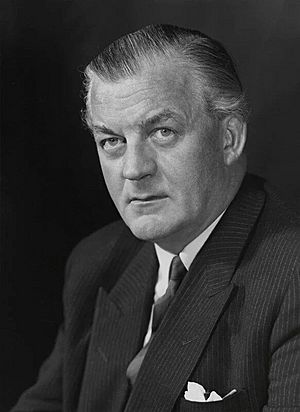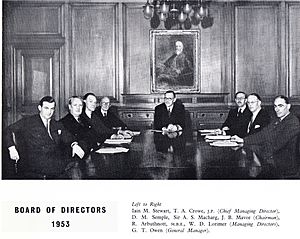Iain Maxwell Stewart facts for kids
Sir Iain Maxwell Stewart (1916–1985) was an important Scottish businessman. He was very interested in making workplaces better for everyone. He wanted to improve how bosses and workers got along.
Contents
Early Life and Family
Sir Iain Maxwell Stewart was the son of William Maxwell Stewart. William had two brothers, Alexander and Frederick. William and Alexander worked in a shipyard in Clydebank, Scotland. Frederick was an electrical engineer. In 1901, the three brothers started their own company in Glasgow. It was called Thermotank. Thermotank made new heating, cooling, and air systems. These systems were used in ships, planes, trains, and buildings.
Iain M Stewart became a ventilating engineer, just like his family. He also became a Lieutenant in the Fife & Forfar Yeomanry. In November 1941, he married Margaret Jean Walker. They lived in Bearsden and had four children.
Business Career
Leading Thermotank
When his uncle Frederick died in 1950, Iain took over the Thermotank business. He was only 34 years old. In 1959, Iain Stewart also became the chairman of Hall-Thermotank Ltd. This company was formed after Thermotank joined with J & E Hall. Thermotank had its main office in Govan, Glasgow. It soon had offices and agents all over the world. Their clients included shipping companies, navies, and railway companies. They also worked with airlines, hotels, and other businesses. Iain Stewart believed in bringing employees and management together. He wanted them to work as a team.
Improving Workplaces
Stewart was the president of the Institution of Engineers and Shipbuilders in Scotland. During this time, he started the Marlow lectures. These lectures began in 1964. They were named after the Marlow Declaration of 1963. The Marlow Declaration was a statement about problems in industry. It talked about treating people fairly in business. It said that businesses have five main responsibilities. These are to employees, shareholders, customers, the local community, and the nation. The declaration also stated that the most valuable part of any company is its people. This includes their skills, loyalty, and enthusiasm.
Sir Iain M Stewart gave £10,000 to help fund the Marlow Lectures. This made them an important event in Scotland. In 1972, Stewart gave the Fifth Marlow lecture. It was titled "Redundancy – the Scrap Heap or a New Job Opportunity?". This talk was about what happens when people lose their jobs.
The Fairfield Experiment
Stewart was a big fan of golf. He was even captain of The Royal and Ancient Golf Club of St Andrews from 1972 to 1973. He played golf with the famous actor Sean Connery. This friendship led to Connery directing a film. The film was called The Bowler and the Bunnet (1967). It showed the Fairfield Shipbuilding and Engineering Company in Glasgow. This company tried a new way of working with employees in the 1960s. It was called the Fairfield Experiment. Stewart started this idea, and George Brown supported it. The company was about to close. Brown agreed to give £1 million to help. This allowed workers, managers, and owners to try new ways of working together. The first ship built under this new system was the Atlantic City in 1967. Stewart said the experiment was working well.
Awards and Other Roles
Stewart was made a knight in 1968. This means he was given the title "Sir". In 1975, he received an honorary Doctor of Laws degree. This was from the University of Strathclyde.
Company Boards
Besides Thermotank, Stewart was a director at many other companies. He was also the vice-chairman of Scottish Television (STV). The founder of STV, Roy Thomson, 1st Baron Thomson of Fleet, invested in Fairfield (Glasgow) Ltd. Sir Iain M Stewart also invested. To help the Fairfield experiment, some STV staff moved to Govan.
He was also a director for companies like Babcock & Wilcox and British Caledonian Airways. He became deputy-chairman of British Caledonian. He also served on the boards of British Airways and the Royal Bank of Scotland. Other companies included the Dorchester Hotel and Radio Clyde. He became chairman of Lyle Shipping Co Ltd.
In 1970, Sean Connery, Sir Iain M Stewart, and F1 racing champion Sir Jackie Stewart started a charity. It was called the Scottish International Educational Trust. It still helps people today. Sir Iain Stewart also left money to start the Sir Iain Stewart Foundation. This foundation also continues its work today.
Death
Sir Iain Maxwell Stewart passed away at his home in December 1985.



